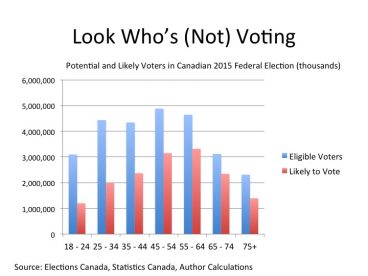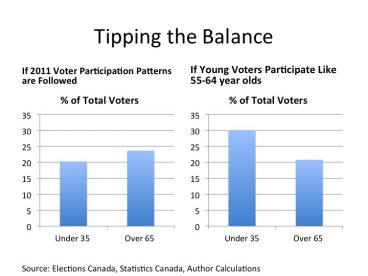The world we live in is morphing into a new one as we speak—that’s a scary prospect for many, but after a presentation by Linda Nazareth, you will feel like you have a handle on the future. The Senior Fellow for Economics and Population Change at policy think-tank The Macdonald-Laurier Institute, Linda is an expert in demographic and economic trends. Her talks focus on what will happen—and what you need to think about to be on the right side of change. Below, Linda writes on the importance of the youth vote in the upcoming Canadian federal election:
Given Canada’s current demographic structure, young voters could potentially be in the driver’s seat this election – if they choose to assume it. If 2011 voter participation patterns are followed, voters in the October Federal Election will be disproportionately aged over 55, with a large swathe being over 65. If, however, any party manages to mobilize the youth vote, we could see a significant shift in who chooses our leaders. Question is, are young voters going to let their parents and grandparents choose a government for them again?
We see it every election: not enough people vote, and those who do are older rather than younger. According to Elections Canada, during the last Federal Election in 2011, the youngest voters were the least likely to vote. Those aged from 18 to 24 had a voter participation rate of 38.8 percent and those aged 20 -34 had a rate of 45.1 percent. At the other end of the spectrum, the voter participation rate for those aged from 45 to 64 was 71.5 percent, while for those aged 65 to 74 it was an incredible 75.1 percent. No wonder then that politicians campaign hard in ‘older’ neighbourhoods.
As elusive as the youth vote has been in recent years, this time round the candidates would be well-served to court it hard. The Millennial Generation – born since 1980 – is increasingly becoming an important population bloc and a potentially important voting bloc as well. If someone can sway their votes this time, it could have a substantial bearing on the outcomes of specific ridings, and perhaps of the entire election. To get an idea of just how powerful the ‘youth’ vote could be, I did a few projections. What I wanted to know is what the distribution of voters was likely to look like if 2011 voting patterns were followed, and what it might look like if younger voters participated more like older ones.
To look at the number of potential voters by age, I used population growth figures from Statistics Canada showing the way that each age group has changed since 2011.[1] I then applied the voter participation rates to each of those groups. Result? If 2011 patterns are followed, we will have a rather old subset of the population choosing our politicians. In fact, if the voter participation rates are the same as they were in 2011, 45 percent of the votes cast will come from those aged 55 and above, and about 24 percent – almost 1 in 4 – will come from those over 65. Just over 20 percent of votes will come from those under 35, even though they now comprise 28 percent of the population compared to 20 percent aged over 65.
Just for a minute, let’s imagine what would happen if young voters did take to the ballot box. To get an idea of how that might shake things up, I decided to apply the voter participation rate of the population aged from 55 to 64 (71.5 percent) to those aged under 35. If that scenario ever took place, it would make a dramatic difference to outcome of the election, in fact giving younger voters a decisive advantage over older ones in choosing the government. As it stands, 20 percent of the voters in this election will be under 35, and 24 percent over 65. Under the imagined scenario, 30 percent of voters would be under 35, and only 21 percent over 65.
Sadly, it does not look particularly likely that young voters will increase their participation rates in this election. In a post-election survey conducted by Statistics Canada in 2011, amongst those 18 to 34 who did not vote around 30 percent said it was because they ‘were not interested in voting’. For them to vote, someone would have to get them interested – which is to say, make them believe there is something for them in participating in the process.
Could disturbingly high youth unemployment rates and buzz about a Canadian recession by enough to get young Canadians to vote? Possibly not. Voting amongst all groups does tend to go higher when the economy is weak, which is something we saw in 2011. Fresh on the heels of the global crisis and a Canadian recession (and increase in the unemployment rate) Canadians voted in greater numbers in 2011 than they did in 2008 in all age groups – except for those under 35. In fact, according to Elections Canada, voter turnout for 25 to 34 year olds was actually lower in 2011 than it was in 2008, the only demographic group for which that wa true. As unhappy as younger Canadians were about the economy, they clearly did not feel that any political party offered much hope to change things around.
So the votes are there for the taking, but they are likely to be as elusive to get in 2015 as they were four years ago. To the politician who can convince younger voters he or she can do something for them will go victory. Younger voters could also have the victory of taking over some political power too – but only if they choose to exercise their democratic rights and actually vote.



